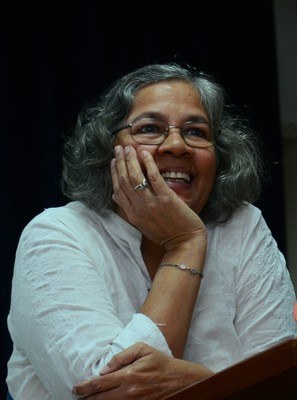Jyotsna Vijapurkar

Designation: ASSOCIATE PROFESSOR (G)
An astronomer by training, I now work in science education. I am currently developing an integrated Middle School inquiry science curriculum. I teach classes myself, and investigate which concepts can be taught, and how, at any given level. I develop low cost easily doable activities in science that teachers and students in even resource poor environments can use.
Research Interests (in Science Education) :
-
Curriculum development
-
Classroom practices
-
Students' alternative concepts and their causes
-
Outcomes of inquiry based teaching
PUBLICATIONS
Recent Journal Articles
- Is the undergraduate microbiology curriculum preparing students for careers in their field?: an assessment of biology majors’ conceptions of growth and control of microorganisms (2018) Aakanksha Purushottam Sawant, Swapnaja Arvind Patil, Jyotsna Vijapurkar,, Needa Nasir Bagban and Deepti Bhushan Gupta International Journal of STEM Education https://stemeducationjournal.springeropen.com/articles/10.1186/s40594-018-0138-z
- Aspects of Teaching and Learning Science: What students' diaries reveal about inquiry and traditional modes (2015) Aisha Kawalkar and Jyotsna Vijapurkar
International Journal of Science Education, 37(13) 2113-2146 http://www.tandfonline.com/doi/full/10.1080/09500693.2015.1067933#abstract
- "Omne vivo ex vivum?" A study of middle school students' explanations of the seemingly sudden appearance of life forms (2014) Jyotsna Vijapurkar and Pooja Konde, Research in Science Education, 44(6) 885-902 http://link.springer.com/article/10.1007/s11165-014-9406-1
- What do cells really look like? An inquiry into students' difficulties in visualising a 3-D biological cell and lessons for pedagogy (2014) Jyotsna Vijapurkar, Aisha Kawalkar, Priya Nambiar Research in Science Education, 44(2) 307-333 (http://link.springer.com/article/10.1007%2Fs11165-013-9379-5#page-1)
- Scaffolding Science talk: The role of teachers' questions in the Inquiry Classroom (2013) Aisha Kawalkar, Jyotsna Vijapurkar International Journal of Science Education, 35(12) 2004-2027, (http://www.tandfonline.com/doi/abs/10.1080/09500693.2011.604684#.VOHC-SV_438)
- Low resolution spectroscopy of hot post-AGB candidates II. LS, LSS, LSE stars and additional IRAS sources, 2012, M.Parthasarathy, J.S.Drilling, Jyotsna Vijapurkar, Y.Takeda Publications of the Astronomical Society of Japan 64, p 57
Books (Can be downloaded from http://coglab.hbcse.tifr.res.in/download-books )
Small Science Class 5 Text book
Small Science Class 5 Work book
Small Science Class 5 Teacher's book
Small Science books in Marathi (Translation by Deepali Palshikar):
Halke Phulke Vigyan 5 Text book
Halke Phulke Vigyan 5 Work book
Halke Phulke Vigyan 5 Teacher's book
Web Publications
A compilation of wild vegetables:
Popular/General Articles
- Unimportance of the right answer, Jyotsna Vijapurkar Ideas page, Indian Express, June 8, 2018
- Different strokes with starch Jyotsna Vijapurkar, Aakanksha Sawant and Swapnaja Patil Teacher Plus, pp 45-46, January 2017
- This big round Earth Teacher Plus, pp 25-31, August 2015
-
Samazlay Na...? (Translation by publisher of 'Did you understand...?", Teacher Plus, ) Shaikshanik Sandarbh,
No. 77, Oct-Nov 2012, p.3
-
Did you understand...?” J. Teacher Plus, vol no. 10, issue No.8, August 2012 p. 44
-
Vignyan vargaat mulanna samjoon ghetana (Translation by publisher of 'Listening to Children's voices in the Science Classroom' Learning Curve, April 2009 issue) Shaikshanik Sandarbh, No. 76, Jun-Jul 2012, p29
-
Listening to Children's voices in the Science Classroom, Learning Curve,, Azim Premji Foundation, Issue 12, April 2009
-
Vigyan ki kaksha mein bacchon ki awaaz (Hindi). Anoupcharika, February 2010 (Original article in English, Learning Curve, April 2009)
-
Being a friend in need, (on encouraging sparrow populations, which are fast declining in our cities) Sunday Herald, Dec 9 2007
-
Are we really teaching Science in our Schools? The Hindu, Friday. March 2 , 2007
In Conference Proceedings
-
Omne Vivum ex vivo”? A study of Middle School students' explanations of the seemingly sudden appearance of some life forms In Nagarjuna G., Jamakhandi, A. and Sam, E. (eds.)epiSTEME 5 International Conference to Review Research on Science,Technology and Mathematics Education, Conference Proceedings. India: Cinnamonteal. p.165-170, 201
-
Aspects of learning science in inquiry and traditional classes: what students' diaries reveal In Nagarjuna G., Jamakhandi, A. and Sam, E. (eds.) epiSTEME 5 International Conference to Review Research on Science, Technology and Mathematics Education, Conference Proceedings. India: Cinnamonteal. p.220-226 (2009)
-
Science talk in the inquiry classroom: An Analysis of teachers' questions and purposes. In Chunawala, S. & Kharatmal, M. (Eds.)(2011) International Conference to Review Research on Science, Technology and Mathematics Education, epiSTEME 4 Conference Proceedings India (2013)
-
Several Lines of Inquiry Into Inquiry Teaching and Learning: Exploring the Affective Outcomes of Inquiry-Oriented Science Teaching. In D. Mogari, A. Mji and U. I. Ogbonnaya (Eds.),Proceedings of ISTE International Conference on Mathematics , Science and Technology Education, p. 265-276. South Africa: University of South Africa.Kawalkar, (2011)
-
What Do Cells Really Look Like? Children’s Resistance to accepting a 3-D Model, In Subramaniam, K., & Mazumdar, A. (Eds.), Proceedings of epiSTEME-3: International Conference to Review Research in Science Technology and Mathematics Education, New Delhi, India: Macmillan, p. 187-191.)(2009)
Document with State & National Agencies
-
Exemplar material on Continuous and Comprehensive Evaluation at the Elementary Stage in Science
( J. Vijapurkar (1 of 10 authors), NCERT, 2013
www.ncert.nic.in/departments/nie/dee/publication/pdf/CCE_Science.pdf